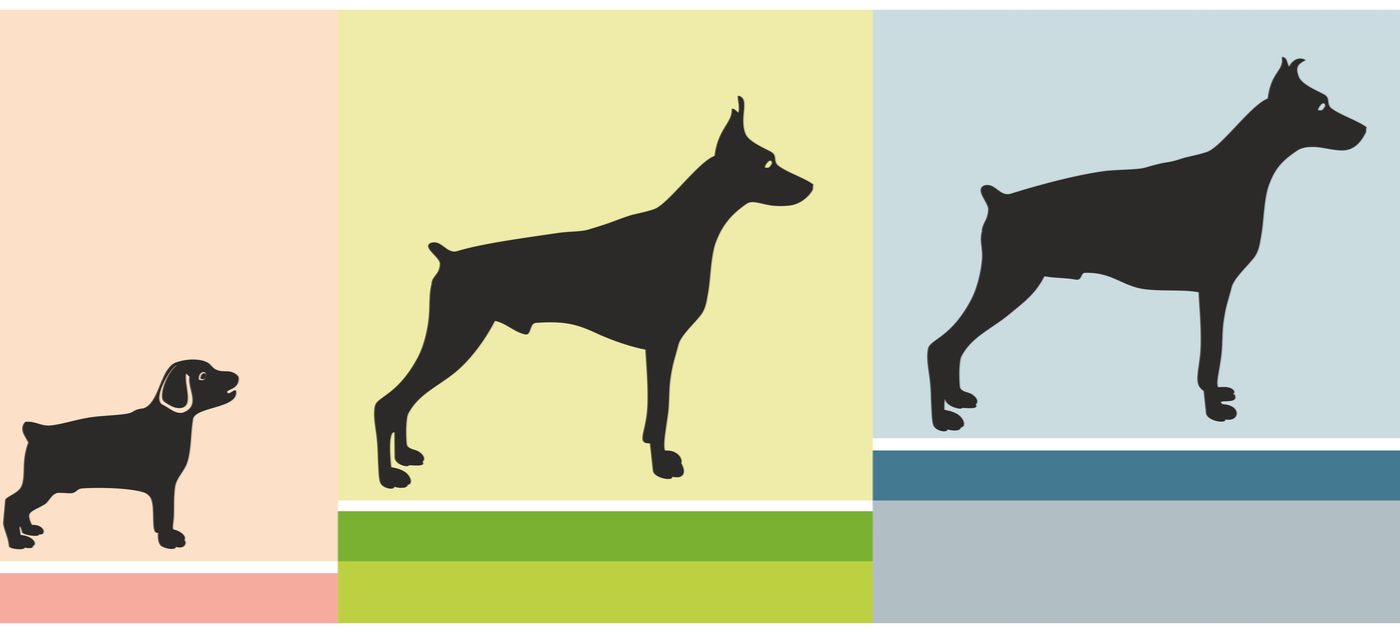Should we multiply the real age of his dog by 7 to obtain the equivalent in the human age of our companion? Our doggies don’t age at all like we humans do. And the breed of the dog, especially its size, plays an important role in the human age equivalent of a dog.
By how much do you multiply the age of a dog?
Should we multiply the dog’s age by 7?
There is this popular belief that multiplying a dog’s actual age by 7 gives you the human equivalent of its age. It’s easy and convenient, but unfortunately, it doesn’t work. And yes, this calculation is too rudimentary to take into consideration the complexity of canine growth.
On the other hand, canine aging is not linear!
A basic model to assess the age of the dog
Another calculation model, simplistic but more evolved than the famous multiplication by 7, estimates that in its first year, a dog ages by the equivalent of 18 years. It’s a lot! In this same model, the dog ages 6 years in the second year, and then 4 years each additional year.
It is well understood by using this method of calculation that each year does not have the same weight. The first year has three times more impact than the second for example! Exit the famous rule of multiplication by 7.
Reading Suggestion: Platinum Dog Food Review and Recommendations For 2021
Small dogs and large dogs do not age at the same rate!
Small dogs grow faster than large dogs
To give you an idea, in the first year of its life, a small dog will age 20 times faster than a human being. A large dog, 16 times faster than a human being.
At 6 months, a small dog will behave like a 15-year-old teenager in human equivalent, while a large dog will behave like an 8-year-old. Suffice to say that the differences are important!
Life expectancy is longer in small dogs
The larger a dog, the lower its life expectancy. Overall, the dog’s life expectancy is, depending on its build, between 10 and 15 years.
Very large dogs that reach adulthood around 2 years or even 3 years will generally not live beyond 8 years. Small dogs, on the other hand, often reach 15 or 16 years old and can even go beyond that.
Other Factors Affecting a Dog’s Life Expectancy
Not everything is defined by its breed and size… There are other factors that influence your pet’s life expectancy, including environmental factors such as the quality of his diet or the frequency of his physical activity.
Another example: a dog living outside, in contact with other dogs, with the risks of illness or confrontation that this entails, will have a lower life expectancy than a house dog who stays all the time at home.

How old is my dog?
It’s a classic question typed on search engines around the world. Previously, we discussed a basic conversion model to assess dog age. We are now going to study the model which is used by veterinarians, and which is a finer and more precise tool.
Age of a dog in human age equivalent: how to calculate it?
We now know that dogs of different breeds and weights will not grow and age at the same rate. The model must therefore take these particularities into account in its method of calculation.
Thus at 9 years old, an 8 kg Cavalier King Charles will have the equivalent of a human age of 56 years while a Newfoundland of 61 kg will have at the same real age a human equivalent of 85 years. In human age equivalent, that makes a difference of 29 human years, at the same age for both dogs!
Reading Suggestion: Happy Dog Food Review and Recommendations for 2021
Conversion table from real dog age to human age equivalent
Below is the conversion table between the real age of your dog in the left column, and the equivalent in human age in the 3 right columns (depending on his weight).
| Actual age of dog | Human age equivalent | Human age equivalent | Human age equivalent |
|---|---|---|---|
Dog under 15 kg | Dog from 15 to 40 kg | Dog over 40 kg | |
| 6 months | 15 years | 10 years | 8 years |
| 2 years | 28 years | 18 years old | 16 years old |
| 2 years | 28 years | 27 years old | 22 years old |
| 3 years | 32 years old | 33 Years | 31 years |
| Four years | 36 years | 39 years old | 40 years |
| 5 years | 40 years | 45 years old | 49 years |
| 6 years | 44 years | 51 years old | 58 years old |
| 7 years | 48 years old | 57 years old | 67 years old |
| 8 years | 52 years | 63 years old | 76 years old |
| 9 years | 56 years old | 69 years old | 85 years old |
| 10 years | 60 years | 75 years | 96 years old |
| 11 years old | 64 years old | 80 years old | 105 years |
| 12 years | 68 years old | 85 years old | 112 years |
| 13 years | 72 years old | 90 years | 120 years |
| 14 years old | 76 years old | 96 years old | – |
| 15 years | 80 years old | 102 years old | – |
| 16 years old | 84 years old | 110 years | – |
| 17 years | 88 years old | – | – |
| 18 years old | 94 years old | – | – |
| 19 years old | 100 years | – | – |
| 20 years | 110 years | – | – |
In other words, at what age can you consider your dog to be old?
At what age is a dog senior?
For that, we will introduce the concept of the threshold of senescence.
What is the senescence threshold?
The threshold of senescence corresponds to the age from which the first signs of old age will appear in your four-legged friend. This does not mean that your dog is old or that he has reached the end of his life in fact, he is no longer entering the second half of his life but rather that he must start to be more vigilant with his. health. Now is the time to take a detailed look at whether he has osteoarthritis or diabetes, especially since these disorders progress with age.
After the threshold of senescence, have your dog regularly checked, in particular his teeth which can come loose and cause him an infection.
What is my dog’s threshold for senescence?
It could not be easier! Refer to the conversion table between actual dog age and human age equivalent above. In the column for each weight class, you will find the age in bold it corresponds to the age at which the dog exceeds the threshold of senescence in its weight class. Thus a dog weighing less than 15 kg will have exceeded its threshold of senescence at 10 years.
Reading Suggestion: 15 Popular Pet Dog Breeds For Family
As for a dog weighing 15 to 45 kg, he will have exceeded his threshold of senescence at 9 years old (age of the real dog), and a dog over 45 kg will have exceeded his threshold of senescence at 8 years old. But don’t worry even after reaching the threshold, your dog still has many years to live!
How to identify the first signs of old age?
There are certain signs that never fool you and should put you on the hook. The following signs of aging are typical:
In this case (s), pay special attention to your dog and go see your veterinarian for an update. And remember that not all races age at the same rate. For both dogs and humans, there is not just one way to age.
Bastards live longer than purebred dogs
“Bastards”, obtained by crossing different breeds of dog, have a higher life expectancy than “pure” breed dogs, the latter having a higher risk of infections. Mixing blood has advantages over inbreeding, which is necessary to preserve a breed, especially when it comes to disease and the immune system.
On the other hand, a mongrel will not age faster, or slower than a purebred dog: on this point, there is no impact.
Some recurring questions about the dog’s age
Some questions often come up about the dog’s age, particularly regarding the end of its growth, the passage to adulthood, or the possibility of reproducing.
How old does a dog grow up to?
At what age does a dog become an adult?
There is no specific age at which a dog becomes an adult. We have seen that its growth depends on its breed, in particular its size (and weight). So the adult age of a dog will also depend on its size class.
It should be noted that a dog becomes an adult between 9 months and 2 years old (three years at the latest for the oldest of them). To assess a dog’s adulthood based on its size:
At what age can a dog breed?
It is recommended to wait until the age of one year at least for the male, and two years for the female.
The maximum age of a dog
The actual dog age conversion chart goes up to 20 years for small dogs, which have a longer life expectancy than larger dogs. But for dogs and humans alike, there are exceptions. We present to you the oldest dog in the world!
The oldest dog in the world
In April 2016 in Australia, Maggie, an “Australian Kelpie” breed, died at the age of 30, which corresponds in human equivalent to approximately 210 years.
Unfortunately, its owner does not have official documents attesting to the date of birth of his dog, this record will never be formalized by the Guinness Book.









